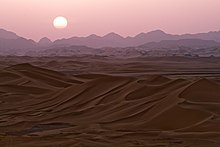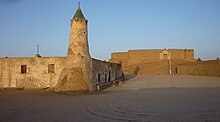This is an old revision of this page, as edited by Dervorguilla (talk | contribs) at 05:52, 30 September 2012 (→History: lk). The present address (URL) is a permanent link to this revision, which may differ significantly from the current revision.
Revision as of 05:52, 30 September 2012 by Dervorguilla (talk | contribs) (→History: lk)(diff) ← Previous revision | Latest revision (diff) | Newer revision → (diff) Place| Fezzan فزان | |
|---|---|
 Fezzan was a governorate within both Italian Libya and the Kingdom of Libya, 1927-1963. Fezzan was a governorate within both Italian Libya and the Kingdom of Libya, 1927-1963. | |
| Capital | Sabha |
| Area | |
| • Total | 551,170 km (212,810 sq mi) |
| Population | |
| • Total | 442,090 |
| • Density | 0.80/km (2.1/sq mi) |
Fezzan (/fɛˈzɑːn/; Template:Lang-ar Fizzān, Berber: Fezzan, Template:Lang-tr, Template:Lang-la) is a south western region of modern Libya. It is largely desert but broken by mountains, uplands, and dry river valleys (wadis) in the north, where oases enable ancient towns and villages to survive deep in the otherwise inhospitable Sahara.
Name
Fezzan derives from the region's Latin Roman name Phasania or Phazania, which may mean "the country of the pheasants" or is related to the Biblical name Phut.
Geography

Fezzan is crossed in the north by the Ash-Shati Valley (Wadi Al Shatii) and in the west by the Wadi Irawan. These two areas, along with portions of the Tibesti Mountains crossing the Chadian border and a sprinkling of remote oases and border posts, are the only parts of the Fezzan able to support settled populations. Large dune seas known as ergs cover much of the remaining land.
History

From the 5th century BCE to the 5th century CE, Fezzan was home to the Garamantian Empire, a state which operated the Trans-Saharan trade routes successively between Carthage and the Roman Empire in North Africa and Sahelian states of west and central Africa.
Roman generals Septimus Flaccus in 19 BCE and Suetonius Paulinus in 50 CE led military expeditions into Sub-Saharan Africa, and Roman explorer Julius Maternus traveled there in early 1st century CE. Paulinus reached Fezzan and went further south. For two–three centuries after this invasion, Fezzan, as part of the Garamantes State, was a client state of the Roman Empire and benefited from Roman civilization.
With the end of the Roman Empire and the following commercial crisis, Fezzan started to lose importance: the population was greatly reduced because of the desertification process of the Sahara during the Middle Ages.
During the 13th and 14th centuries, portions of Fezzan were part of the Kanem Empire, while the Ottoman rulers of North Africa asserted their control over the region in the 17th century. In the period of Abdulhamid II (1876-1909) Fizan also used as a place of political exile for Young Turks (Jeune Turcs) because it is the most remote province from Istanbul.
Beginning in 1911, Fezzan was occupied by Italy. However, Italy's control of the region was precarious until at least 1923, with the rise of the Italian Fascist regime. The Italians were resisted in their early attempts at conquest by Berber and Arab adherents to the militant Sanusiya Sufi religious order. The Tuareg clans of the region were only pacified by European expansion before the Second World War and some of them collaborated with the Italian Army in the North African Campaign.
Free French troops occupied Murzuk, a chief town of Fezzan, on 16 January 1943, and proceeded to administer Fezzan with a staff stationed in Sabha. But French administration was largely exercised through Fezzan notables of the family of Sayf an Nasr. Disquieting to the tribes in western Fezzan was the administrative attachment of Ghat, and its surrounding area, to French-ruled Algeria. However, when the French military control ceased in 1951, all of Fezzan became part of the Kingdom of Libya.

Fezzan was a stronghold for Libyan leader Muammar Gaddafi through much of the Libyan civil war, though starting in July, anti-Gaddafi forces began to gain ground, taking control of the region's largest city of Sabha in mid-to-late September.
The LF country code (.lf) was reserved “on behalf” of Libya Fezzan (for an “indeterminate period of time”) by the International Organization for Standardization (ISO).
Administration
Fezzan was a province under the Ottoman Turks and Italy, and a province (wilayah) or governorate (muhafazah) of independent Libya (alongside Tripolitania and Cyrenaica) until 1963. With the introduction of the new administrative division of Libya in 1963, Fezzan was abolished as an independent administrative unit and was divided into the muhafazat (governorates) of Awbari and Sabha. In 1983, these administrative divisions were abolished in favour of smaller districts or baladiyah. The Baladiyat-system was reorganized in 1987 and was replaced in 1995 by the Sha'biyat-system.

The former Fezzan province contains the districts (Sha'biyat) of Wadi al Shatii, Wadi al Hayaa, Jufra, Ghadames, Murzuq, Sabha and Ghat (other maps allocate Ghadames to the neighbouring region of Tripolitania). The historic capital, largest city, political and administrative centre is Sabha.
Population
The region's inhabitants include the nomadic Tuareg in the southwest and the Toubou in the southeast. These pastoralist populations often cross the borders of Algeria, Chad and Niger freely. In the north, Arab, Berber and settled Tuareg and Toubou mix. While making up some 30% of the land area of Libya, the Fezzan supports little of its population. Despite this, large towns like Sabha, survive on near-surface water in the wadis of the north and west. The northeast area is dominated by Haruj, a large and unpopulated volcanic field.
Fezzan's population has grown rapidly since the mid 20th century along with the overall growth in Libya's population, and the province's share of the national population has increased slightly.
| Year | Population | Percent of Libya's population |
|---|---|---|
| 1954 | 59,315 | 5.4 |
| 1964 | 79,326 | 5.1 |
| 1973 | 128,012 | 5.7 |
| 1984 | 213,915 | 5.9 |
| 1995 | 352,276 | 7.3 |
| 2006 | 442,090 | 7.8 |
Source: Gathered from bulletins of censuses 1964, 1973, 1995, 2006.
See also
- List of colonial heads of Fezzan
- Postage stamps and postal history of Fezzan and Ghadames
- List of French possessions and colonies
- Germa Museum
Notes
- Abdel Aziz Tarih Sharaf, “Jughrafia Libia”, Munsha’at al Ma’arif, Alexandria, 2nd ed., 1971, pp.232-233.
- 2006 census, based on the sum of population of districts Murzuq, Sabha, Wadi al Hayaa, Ghat, Jufra, Wadi al Shatii
- Présence africaine. Editions du Seuil, 1975; p. 477.
- Comptes rendus sténographiques ... Imprimerie Nationale, 1881; pp. 864-865 (fn. 1). (In French)
- deGraft-Johnson (1954) African Glory, p. 26
- Jön Türklerin Korkulu Rüyası: Fizan denen şu yer! (tr)
- ^ Berry, LaVerle Bennette "Chapter 1 - Historical Setting -World War II and Independence - Allied Administration" Area Handbook for Libya (1987 edition) Federal Research Division, Library of Congress, Washington, DC; available at: A Country Study: Libya, accessed 17 May 2009
- Wedeman, Ben (20 September 2011). "Government forces enter Libya's Sabha, to cheers". CNN. Retrieved 20 September 2011.
- "ISO 3166-1 Decoding Table". ISO. 2012.
LF - Libya Fezzan - indeterminately reserved
External links
- Map from Google showing a large area of Fezzan and its important cities.
- Worldstatesmen.org's History and list of rulers of Fezzan.
- Hostkingdom.net's History and list of rulers of Fezzan.
- Lexiorient.com's article on Fezzan.
| Historical regions of Libya | |||
|---|---|---|---|
26°19′58″N 13°25′31″E / 26.3328°N 13.4253°E / 26.3328; 13.4253
Categories: